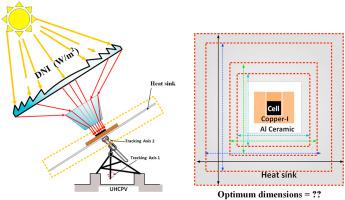Case Studies in Thermal Engineering ( IF 6.4 ) Pub Date : 2020-09-28 , DOI: 10.1016/j.csite.2020.100757 Oussama Rejeb , Ali Radwan , Essam M. Abo-Zahhad , Chaouki Ghenai , Ahmed A. Serageldin , Mostafa Ahmed , Ahmed A.H. El-Shazly , Maamar Bettayeb , O. Abdelrehim

|
In the high concentrator photovoltaic (HCPV) systems with solar concentration ratios up to 2000 Suns, significant heat is generated in the used solar cell layer. This high generated heat requires an efficient and smart cooling technique to keep it operating at a safe operating temperature. In this paper, another ultra-high concentrator photovoltaic (UHCPV) system with a smaller cell area of 1 mm2 operating at a high solar concentration ratio (CR) up to 10,000 Suns is proposed. This smaller area requires a simple passive cooling technique even at high CR. The optimal dimensions of a passive cooling method using heat spreader are defined. A 3D thermal model for the multijunction solar cell with the heat spreader coupled with the multi-objective genetic optimization algorithm is used to define the optimal heat spreader dimensions . The model is validated with the results in the literature. The model is used to estimate the cell temperature generated electric power, and cell efficiency at different wind speed, ambient temperature, solar radiation, heat spreader length, thickness, and CR. The heat spreader dimensions were optimized for CR = 6000 suns, the optimal thickness and length were 2 mm and a of 47.5 mm, respectively. These dimensions are enough for the safe operation of the UHCPV at CR of 6000 Suns. As a case study, for a UHCPV module with a total number of cells of 10 by 10, the generated power is around 319 W at CR of 10,000 Suns. At the same condition, the monocrystalline silicon solar cell in the PERSEID SOLAR company can generate a maximum power of 144.9 W/m2. For the same area, for the UHCPV module, the generated electric power is around 319 W for 1 m2 of the module. Therefore, around 120% increase in the power can be accomplished with the use of the UHCPV module. In the UHCPV module, the total area of the cell is around 1 cm by 1 cm. Therefore, the module cost could be very low.
中文翻译:

基于最优散热器设计的被动冷却超高聚光光伏电池数值分析
在太阳能聚集比高达2000 Sun的高聚光光伏(HCPV)系统中,用过的太阳能电池层会产生大量热量。产生的大量热量需要高效且智能的冷却技术,以使其保持在安全的工作温度下。在本文中,另一种超高聚光光伏(UHCPV)系统具有1 mm 2的较小单元面积建议在高达10,000太阳的高太阳聚集率(CR)下运行。即使在高CR时,这种较小的区域也需要简单的被动冷却技术。定义了使用散热器的被动冷却方法的最佳尺寸。使用带有散热器的多结太阳能电池的3D热模型,结合多目标遗传优化算法,来定义最佳散热器尺寸。该模型已用文献中的结果进行了验证。该模型用于估计在不同风速,环境温度,太阳辐射,散热器长度,厚度和CR下电池温度产生的电能以及电池效率。散热器尺寸针对CR = 6000太阳进行了优化,最佳厚度和长度分别为2 mm和47.5 mm。这些尺寸足以确保UHCPV在6000太阳的CR下安全运行。作为案例研究,对于具有10×10单元总数的UHCPV模块,在10,000 Sun的CR下产生的功率约为319W。在相同条件下,PERSEID SOLAR公司的单晶硅太阳能电池可产生的最大功率为144.9 W / m2。对于同一面积,对于UHCPV模块,对于1 m 2的模块,所产生的电能约为319W 。因此,使用UHCPV模块可以实现大约120%的功率增加。在UHCPV模块中,电池的总面积约为1 cm x 1 cm。因此,模块成本可能非常低。











































 京公网安备 11010802027423号
京公网安备 11010802027423号